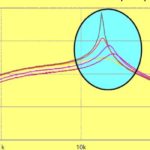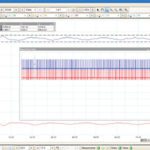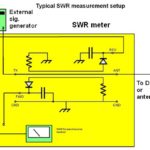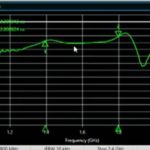The newly announced PicoVNA 108 comes in the same low-cost, small-footprint and portable format as the widely used PicoVNA106 6 GHz instrument. The PicoVNA 108 can see out further to 8.5 GHz and it can see down deeper to –124 dB. It provides new “save on trigger” synchronization for multiple measurements, for example, with changing conditions or multiplexed measurement routings. This, added to the convenience of integrated bias-Ts, speeds batch test and device characterizations. We have also added offset frequency capability to the Quad RX four-receiver architecture and synchronization and control of the PicoSource AS108 8-GHz agile synthesizer from within PicoVNA 3 software. This instrument partnership allows RF mixer and RF/IF system characterizations using the PicoVNA 108. Other popular third-party signal generators are also supported.
The PicoVNA 108 can deliver all four s-parameters in as little as 190 µsec, with high dynamic range and  accuracy. The PicoVNAs achieve substantial cost saving for the professional user and are affordable to small and start-up businesses, volume users in the classroom and even some amateur users. Price is comparable with traditionally lower-cost single-port reflectometers and even scalar network analyzers of similar bandwidth. “More is better” and “more costs less” with the PicoVNA.
accuracy. The PicoVNAs achieve substantial cost saving for the professional user and are affordable to small and start-up businesses, volume users in the classroom and even some amateur users. Price is comparable with traditionally lower-cost single-port reflectometers and even scalar network analyzers of similar bandwidth. “More is better” and “more costs less” with the PicoVNA.
Many engineers will be aware that calibration standards and interconnects can both dominate measurement errors in network analysis, so Pico supports both PicoVNA models with low-cost but equally impressive SMA and PC3.5 calibration standards and test leads, all with precision-machined stainless steel connectors. PicoVNA software supports 8- or 12-term calibration, including the “unknown thru” method. Unwanted measurement contributions from feedlines or test jigs can be eliminated using manual or auto-sensed reference plane shift, normalization or de-embedded Touchstone, taken from either measurement or EM simulation. Fast Fourier time-domain transformation and impedance transformation are both included as standard. TDT/TDR plots have a system rise time down to 58 psec and these support resistance and distance to fault readout out to over 100 m.
Pico Technology, 320 N Glenwood Blvd., Tyler TX 75702, 800 591 2796, 620 272 0981, www.picotech.com






Leave a Reply
You must be logged in to post a comment.